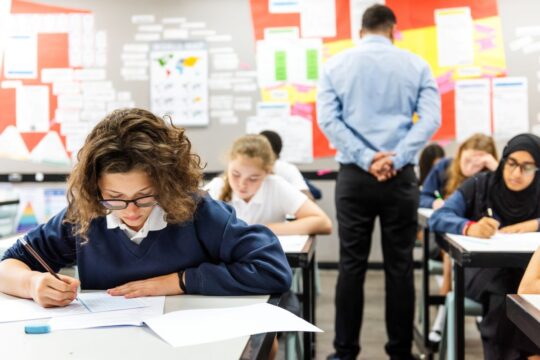Assessment is an essential part of instruction and plays a key role in every student’s learning journey. While there are plenty of ways to assess students, the process can sometimes feel time-consuming and overwhelming.
However, it’s a powerful tool for guiding instruction, providing feedback, and helping students grow. When used intentionally and thoughtfully, assessments can do so much more than measure learning; they can improve it.
Start with Clear Learning Goals
Before diving right into creating assessments, it’s worth stepping back and asking: What exactly do I want students to walk away knowing or being able to do? Setting clear, student-friendly learning targets sets the foundation for strong assessments. When students understand the why behind what they’re learning, they’re more likely to stay engaged and track their own progress.
Consider writing your learning objectives in “I can” statements that are simple, concrete, and kid-friendly. For example:
- “I can compare and contrast characters in a story.”
- “I can solve multi-step math problems using equations.”
- “I can explain the main idea of a nonfiction text.”
- “I can describe the water cycle using the correct vocabulary.”
- “I can show respect during group work by listening and taking turns.”
Once your goals are clear, it becomes a lot easier to create assessments that actually measure what you set out to teach.
Use regular check-ins to guide teaching
Keep checking in with students as you go, not just at the end. This will help you spot which students are getting it and which are not, before it’s time to grade something. Here are a few ideas that work really well in classrooms.
- Exit tickets: A few targeted questions at the end of a lesson can tell you a lot about what sank in and what still needs work.
- Thumbs up/down: An easy visual during lessons that gives you instant feedback.
- Think-pair-share: Encourages students to explain their thinking and helps you gauge understanding as you circulate.
- Whiteboard responses: Students can solve a problem or answer a question and hold it up, great for instant feedback.
- Quick writes: Give students a prompt and one to two minutes to jot down their thoughts. It’s a simple way to check for understanding and see how well they’re connecting with the material.
Regular check-ins aren’t just about gathering data, they also allow students to reflect on what they are learning. This reflection is when growth happens.
Give Feedback Students Can Use
Feedback isn’t just about pointing out what’s right or wrong, it should be clear and helpful and help students understand how to improve. Consider focusing less on grades and more on comments that push students to reflect and revise. Instead of “Good job” or “Needs work,” get specific:
- “You explained the first step clearly, but your second step is missing a key detail. Try going back and checking your math.”
- “Great use of evidence in your paragraph! Can you add one more sentence to explain how it supports your argument?”
- “Your introduction grabs attention well. Now try adding a sentence that clearly states your main idea.”
Even better, build in time for students to do something with that feedback. Give them a chance to revise, rework, or reflect. That’s where real learning happens. Feedback needs to lead to change, so make sure to tell students what they did well and what to work on.
Keep Rubrics Student-Friendly
Rubrics can be powerful tools for both teachers and students, but only if they’re written in a way kids understand. Instead of heavy jargon or vague categories, use clear, concrete language. For example,
- “My ideas are clear and organized.”
- “I used evidence to support my thinking.”
- “I made some mistakes in punctuation, but my meaning is still clear.”
Consider co-creating rubrics with your class. When students help define what quality work looks like, they’re more invested in reaching that standard. Plus, it helps demystify grading.
Incorporate Student Self-Assessment
One strategy that’s often overlooked is student self-assessment, but it’s so much more than just handing out a rubric and asking kids to rate themselves. Done right, it’s a powerful way to put students in the driver’s seat of their own learning.
Self-assessment encourages reflection, builds ownership, and helps students set meaningful goals for growth. This doesn’t have to be complex or time-consuming. Try using:
- Simple reflection questions like “What part of this was hard for me?” or “What do I still need help with?”
- Color-coded rubrics where students highlight where they think their work falls.
- Goal-setting sheets where students decide what to work on next.
When students are taught how to self-assess, they become better learners, not just better test-takers.
Differentiate Your Assessments
We differentiate instruction all the time—so why not assessments, too? Not all students express their learning in the same way. Some may thrive with written responses, while others do better with visual or verbal formats. Consider offering assessment choices. For example,
- A written essay or a recorded podcast
- A traditional quiz or a visual infographic
- A timeline or a short comic strip
- A song/rap or a poem summarizing the topic
- A blog post or a series of social media-style updates
When students get to choose the format that best fits their learning style, they’re more likely to feel successful, and you’re more likely to get an accurate picture of what they really know and understand.
Let student results guide your teaching
Once you collect student data, the next step is using it to guide your teaching. Did most of the class bomb that quiz? Time to reteach. Did a handful of students really excel? Maybe they’re ready for an enrichment challenge. Adjust your teaching based on what’s working (and what’s not).
Assessment should be a two-way street: not just a measure of student progress, but a reflection on your instruction, too. This is where tools like spreadsheets, color-coded charts, or even just sticky notes on your clipboard come in handy. Keep it manageable, but also make it meaningful.
There’s no one-size-fits-all when it comes to assessment. What matters is being intentional, thoughtful, and responsive. When you use assessment as a guide rather than a judgment, you open the door for real, meaningful learning to happen.
So go ahead and consider tweaking that rubric, trying out a new formative check-in, or giving students a little more say in how they show what they know. The impact will be worth it. And in the process, you’re not just improving learning outcomes. You’re helping your students become reflective, confident, and capable learners for life.
Educators never stop learning; check out our available graduate degree programs to hone your skills and promote lifelong learning and academic excellence.




